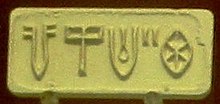Indus script
script, short strings of symbols associated with the Indus Valley Civilization
Indus script is a collection of symbols that was used by the Indus Valley Civilization. They were used from about 2.500 BC to about 1.900 BC. Most inscriptions are extremely short. About 400 symbols are known. Scientists do not agree if these symbols were used as a writing system to record a language. So far no bilingual text have been found. An example of a bilinhial text us the Rosetta stone which has the same text in three different languages.
| Indus script | |
|---|---|
 Seal impression showing a typical inscription of five characters | |
| Script type | Undeciphered
possible Bronze Age writing |
Time period | 3500–1900 BCE[1][2][3] |
| Direction | Right to left[4][5] [6] |
| Languages | Unknown (see Harappan language) |
| ISO 15924 | |
| ISO 15924 | Inds (610), Indus (Harappan) |


References
change- ↑ David Whitehouse (May 4, 1999). "'Earliest writing' found". BBC News. Retrieved 2 September 2014.
- ↑ "Evidence for Indus script dated to ca. 3500 BCE". Retrieved 2 September 2014.
- ↑ Edwin Bryant (2001). The Quest for the Origins of Vedic Culture: The Indo-Aryan Migration Debate. Oxford University. p. 178. ISBN 978-0-19-513777-4.
- ↑ Lal, B. B. (1979). "'Earliest writing' found". East and West. 29 (1/4): 27–35. JSTOR 29756504.
- ↑ Rao, Rajesh P. N. "A Rosetta Stone for a lost language".
- ↑ Rao, Rajesh P. N.; Yadav, Nisha; Vahia, Mayank N.; Joglekar, Hrishikesh; Adhikari, R.; Mahadevan, Iravatham (29 May 2009). "Entropic Evidence for Linguistic Structure in the Indus Script" (PDF). Science. 324 (5931): 1165. doi:10.1126/science.1170391. PMID 19389998. S2CID 15565405.